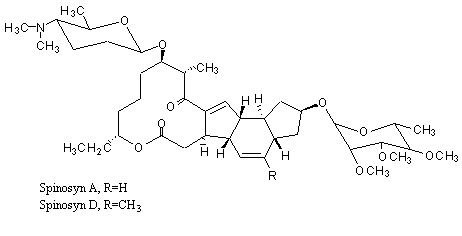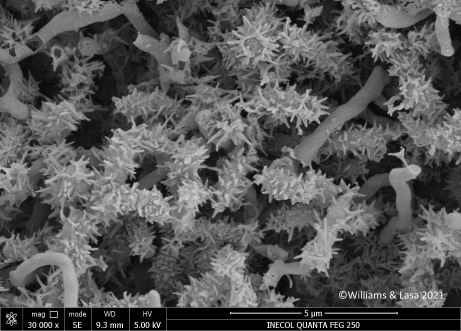Spinosad is a naturally-derived insecticide produced by fermentation of Saccharopolyspora spinosa, an actinomycete bacterium originally isolated from a Caribbean soil sample.
It is a neurotoxin comprising a mixture of spinosyns A and D (hence spinosAD), which are tetracyclic-macrolide
compounds that uniquely act on a subgroup of the post-synaptic nicotinic
acetylcholine receptors on the nerve cells of certain insects.
In reality, S. spinosa produces a great many spinosyn
compounds. For example, spinosyns J and L have now been chemically modified
to produce the product spinetoram (Palgus®) that has greater environmental
stability and a more rapid speed of kill than spinosad.
|

The difference between spinosyns A and D lies in the "R" group. Small structural differences in other spinosyns have important effects on their biological activity. |

Electron microscope image of Saccharopolyspora spinosa showing the
characteristic spiny appearance and filamentous-type growth. |
Spinosad is highly active by ingestion and to a lesser degree by contact.
Spinosad-based products have been registered in more than 30 countries for
control of pest caterpillars (Lepidoptera), flies (Diptera), some beetles (Coleoptera),
termites, ants and thrips.
Spinosad has very little mammalian toxicity and is classified by the United States Environmental Protection Agency as an environmentally and toxicologically reduced risk material.
A review of predator and parasitoid susceptibility to spinosad concluded
that this product represented one of the most judicious insecticides
available for the conservation of predator populations (Williams et al., 2003).
However, laboratory studies often report adverse effects on populations of
parasitoid wasps.
Sublethal effects on longevity and reproduction are also more commonly
observed in parasitoid wasps compared to predatory insects.
|
The need for accurate assessment of the environmental impact of agrochemicals is clear. Large areas are now being treated with spinosad, for example to control fruit flies.
Spinosad in granular and liquid formulations is also being increasingly used
to control medically important mosquitoes that transmit diseases such as
dengue and Zika virus.
Studies in Mexico have demonstrated the high efficacy of spinosad against
the most important vectors of human disease, including Aedes aegypti
and Aedes albopictus as these mosquitoes become increasingly
resistant to the organophosphate insecticide temephos (Williams
et al., 2019)
My work has focused mostly on:
● Evaluation of the toxicity of spinosad to non-target insects, particularly natural enemies (insect predators and parasitoids).
● Use of ultra-low rates of spinosad in granular feeding stimulants for control of fall armyworm (Spodoptera frugiperda)
(Tamez-Guerra et al., 2018).
● Efficacy of spinosad for control of the larval stages of mosquitoes
(Aedes, Culex, Anopheles) in different types of
habitats.
|

A student collects and counts Aedes
larvae from spinosad-treated car tires in an experiment performed in
Veracruz State, Mexico.
|




